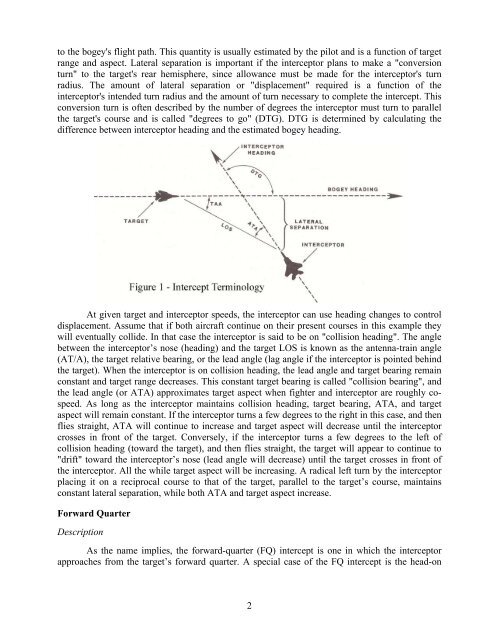Tactical Intercepts.pdf - e-HAF
Tactical Intercepts.pdf - e-HAF
Tactical Intercepts.pdf - e-HAF
You also want an ePaper? Increase the reach of your titles
YUMPU automatically turns print PDFs into web optimized ePapers that Google loves.
to the bogey's flight path. This quantity is usually estimated by the pilot and is a function of target<br />
range and aspect. Lateral separation is important if the interceptor plans to make a "conversion<br />
turn" to the target's rear hemisphere, since allowance must be made for the interceptor's turn<br />
radius. The amount of lateral separation or "displacement" required is a function of the<br />
interceptor's intended turn radius and the amount of turn necessary to complete the intercept. This<br />
conversion turn is often described by the number of degrees the interceptor must turn to parallel<br />
the target's course and is called "degrees to go" (DTG). DTG is determined by calculating the<br />
difference between interceptor heading and the estimated bogey heading.<br />
At given target and interceptor speeds, the interceptor can use heading changes to control<br />
displacement. Assume that if both aircraft continue on their present courses in this example they<br />
will eventually collide. In that case the interceptor is said to be on "collision heading". The angle<br />
between the interceptor’s nose (heading) and the target LOS is known as the antenna-train angle<br />
(AT/A), the target relative bearing, or the lead angle (lag angle if the interceptor is pointed behind<br />
the target). When the interceptor is on collision heading, the lead angle and target bearing remain<br />
constant and target range decreases. This constant target bearing is called "collision bearing", and<br />
the lead angle (or ATA) approximates target aspect when fighter and interceptor are roughly cospeed.<br />
As long as the interceptor maintains collision heading, target bearing, ATA, and target<br />
aspect will remain constant. If the interceptor turns a few degrees to the right in this case, and then<br />
flies straight, ATA will continue to increase and target aspect will decrease until the interceptor<br />
crosses in front of the target. Conversely, if the interceptor turns a few degrees to the left of<br />
collision heading (toward the target), and then flies straight, the target will appear to continue to<br />
"drift" toward the interceptor’s nose (lead angle will decrease) until the target crosses in front of<br />
the interceptor. All the while target aspect will be increasing. A radical left turn by the interceptor<br />
placing it on a reciprocal course to that of the target, parallel to the target’s course, maintains<br />
constant lateral separation, while both ATA and target aspect increase.<br />
Forward Quarter<br />
Description<br />
As the name implies, the forward-quarter (FQ) intercept is one in which the interceptor<br />
approaches from the target’s forward quarter. A special case of the FQ intercept is the head-on<br />
2
















